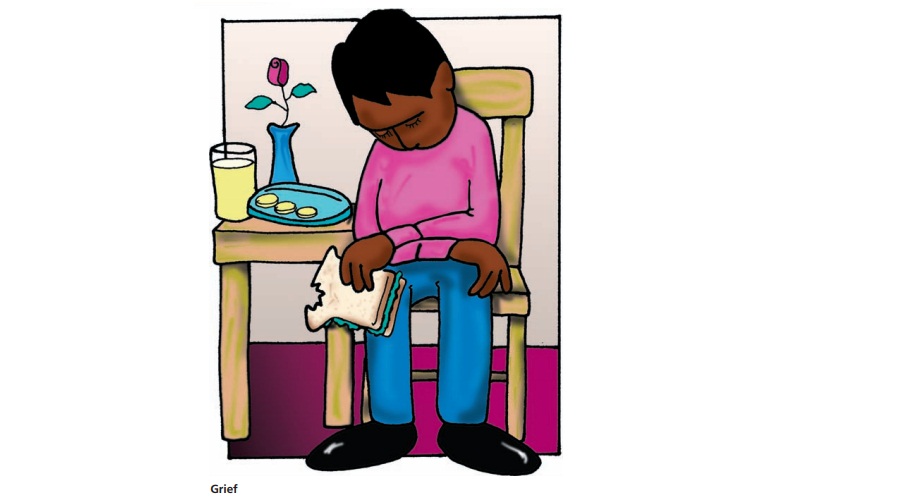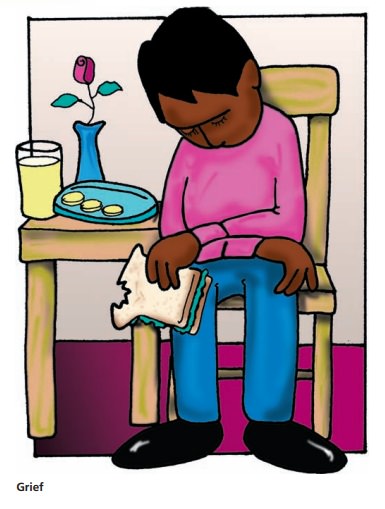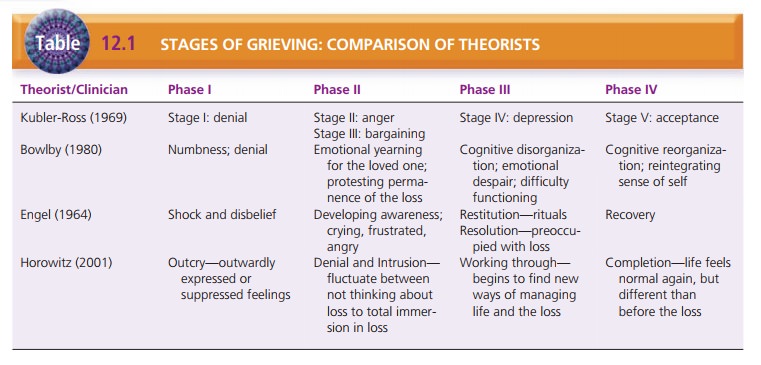Chapter: Psychiatric Mental Health Nursing : Grief and Loss
The Grieving Process

THE GRIEVING PROCESS
Nurses interact with clients responding to myriad losses along the
continuum of health and illness. Regardless of the type of loss, nurses must
have a basic understanding of what is involved to meet the challenge that grief
brings to clients. By understanding the phenomena that clients![]()
![]() experience as they deal with the discomfort of
loss, nurses may promote the expression and release of emotional as well as
physical pain during grieving. Supporting this process means ministering to
psychological—and physical—needs.
experience as they deal with the discomfort of
loss, nurses may promote the expression and release of emotional as well as
physical pain during grieving. Supporting this process means ministering to
psychological—and physical—needs.
The therapeutic relationship and therapeutic commu-nication skills
such as active listening are paramount when assisting grieving clients.
Recogniz-ing the verbal and nonverbal communication content of the various
stages of grieving can help nurses to select interventions that meet the
client’s psychological and physical needs.

Theories of Grieving
Among well-known theories of
grieving are those posed by Elizabeth Kubler-Ross, John Bowlby, George
Engel, and Mardi Horowitz.
Kubler-Ross’s Stages of Grieving
Elisabeth Kubler-Ross (1969) established a basis for under-standing
how loss affects human life. As she attended to clients with terminal
illnesses, a process of dying became apparent to her. Through her observations
and work with dying clients and their families, Kubler-Ross developed a model
of five stages to explain what people experience as they grieve and mourn:
·
Denial is shock and disbelief
regarding the loss.
·
Anger may be expressed toward God,
relatives, friends, or health care
providers.
·
Bargaining occurs when the person asks
God or fate for more time to delay
the inevitable loss.
·
Depression results when awareness of the
loss becomes acute.
·
Acceptance occurs when the person shows
evidence of coming to terms with
death.
This model became a prototype for care providers as they looked for
ways to understand and assist their clients in the grieving process.
Bowlby’s Phases of Grieving
John Bowlby, a British psychoanalyst, proposed a theory that humans
instinctively attain and retain affectional bonds with significant others
through attachment behav-iors. These
attachment behaviors are crucial to the development
of a sense of security and survival. People experience the most intense
emotions when forming a bond such as
falling in love, maintaining a bond
such as loving someone, disrupting a
bond such as in a divorce, and renewing
an attachment such as resolving a conflict or renewing a relationship (Bowlby,
1980). An attach-ment that is maintained is a source of security; an
attach-ment that is renewed is a source of joy. When a bond is threatened or
broken, however, the person responds with anxiety, protest, and anger.
Bowlby described the grieving process as having four phases:
·
Experiencing numbness and denying the loss
·
Emotionally yearning for the lost loved one and pro-testing the
permanence of the loss
·
Experiencing cognitive disorganization and emotional despair with
difficulty functioning in the everyday world
·
Reorganizing and reintegrating the sense of self to pull life back
together.
Engel’s Stages of Grieving
George Engel (1964) described five stages of grieving as follows:
·
Shock and disbelief: The initial reaction to a
loss is a stunned, numb feeling
accompanied by refusal to ac-knowledge the reality of the loss in an attempt to
pro-tect the self against overwhelming stress.
·
Developing awareness: As the individual begins to
ac-knowledge the loss, there may be crying, feelings of helplessness,
frustration, despair and anger that can be directed at self or others,
including God or the deceased person.
·
Restitution: Participation in the rituals
associated with death, such as a
funeral, wake, family gathering, or religious ceremonies that help the
individual accept the reality of the loss and begin the recovery process.
·
Resolution of the loss: The individual is preoccupied with the loss, the lost person or
object is idealized, the mourner may even imitate the lost person. Eventually,
the preoccupation decreases, usually in a year or per-haps more.
·
Recovery: The previous preoccupation
and obsession ends, and the individual
is able to go on with life in a way that encompasses the loss.
Horowitz’s Stages of Loss and Adaptation
Mardi Horowitz (2001) divides normal grief into four stages of loss
and adaptation:
·
Outcry: First realization of the loss. Outcry may be out-ward, expressed by
screaming, yelling, crying, or col-lapse. Outcry feeling can also be suppressed
as the person appears stoic, trying to maintain emotional con-trol. Either way,
outcry feelings take a great deal of energy to sustain and tend to be short-lived.
·
Denial and intrusion: People move back and forth
dur-ing this stage between denial and intrusion. During de-nial, the person
becomes so distracted or involved in activities that he or she sometimes isn’t
thinking about the loss. At other times, the loss and all it represents
intrudes into every moment and activity, and feelings are quite intense again.
Working through: As time passes, the person
spends less time bouncing back and
forth between denial andintrusion, and the emotions are not as intense and
over-whelming. The person still thinks about the loss, but also begins to find
new ways of managing life after loss.
·
Completion: Life begins to feel “normal”
again, although life is different
after the loss. Memories are less painful and don’t regularly interfere with
day-to-day life. Epi-sodes of intense feelings may occur, especially around
anniversary dates, but are transient in nature.
Table 12.1 compares the stages of grieving theories.

Tasks of Grieving
Grieving tasks, or mourning, that the
bereaved person faces involve active
rather passive participation. It is some-times called “grief work” because it
is difficult and requires tremendous effort and energy to accomplish.
Rando (1984) describes tasks inherent to grieving that she calls
the “six R’s”:
·
Recognize: Experiencing the loss, and
understanding that it is real, it has
happened.
·
React: Emotional response to loss,
feeling the feelings.
·
Recollect and re-experience: Memories are reviewed and relived.
·
Relinquish: Accepting that the world has
changed (as a result of the loss),
and there is no turning back.
·
Readjust: Beginning to return to daily
life; loss feels less acute and
overwhelming.
·
Reinvest: Accepting changes that have
occurred; re-entering the world, forming new relationships and commitments.
Worden (2008) views the tasks of grieving as follows:
1.
Accepting the reality of the loss: It is common for peo-ple
initially to deny that the loss has occurred, it is toopainful to be
acknowledged fully. Over time, the person wavers between belief and denial in
grappling with this task. Traditional rituals, such as funerals and wakes, are
helpful to some individuals.
2. Working through the pain of
grief: A loss causes pain, both physical and emotional, that must be
acknowl-edged and dealt with. Attempting to avoid or suppress the pain may
delay or prolong the grieving process. The intensity of pain and the way it is
experienced varies among individuals, but it needs to be experienced for the
person to move forward.
3. Adjusting to an environment
that has changed because of the loss. It may take months for the person to
realize what life will be like after the loss. When a loved one dies, roles
change, relationships are absent or different, lifestyle may change, and the
person’s sense or identity and self-esteem may be greatly affected. Feelings of
fail-ure, inadequacy, or helplessness at times are common. The individual must
develop new coping skills, adapt to the new or changed environment, find
meaning in the new life, and regain some control over life to con-tinue to
grow. Otherwise, the person can be in a state of arrested development and get
stuck in mourning.
4. Emotionally relocating that
which has been lost and moving on with life. The bereaved person identifies a
special place for what was lost and the memories. The lost person or
relationship is not forgotten or diminished in importance, but rather is
relocated in the mourner’s life as the person goes on to form new relationships,
friends, life rituals, and moves ahead with daily life.
Related Topics